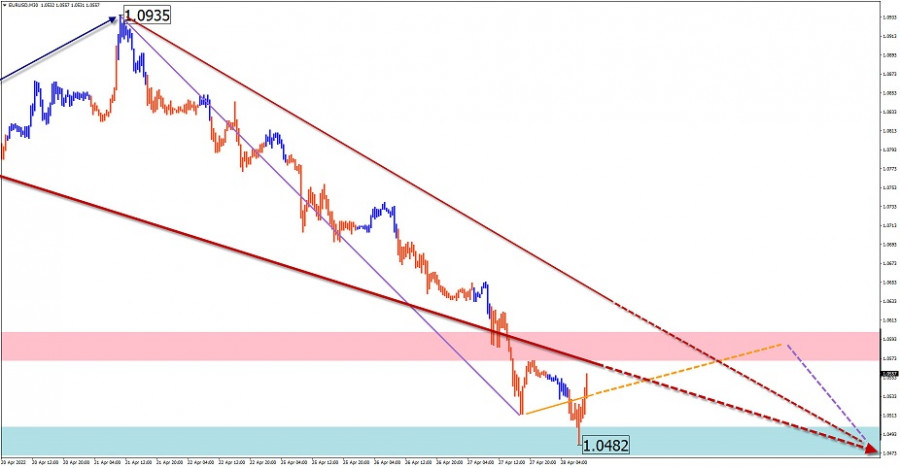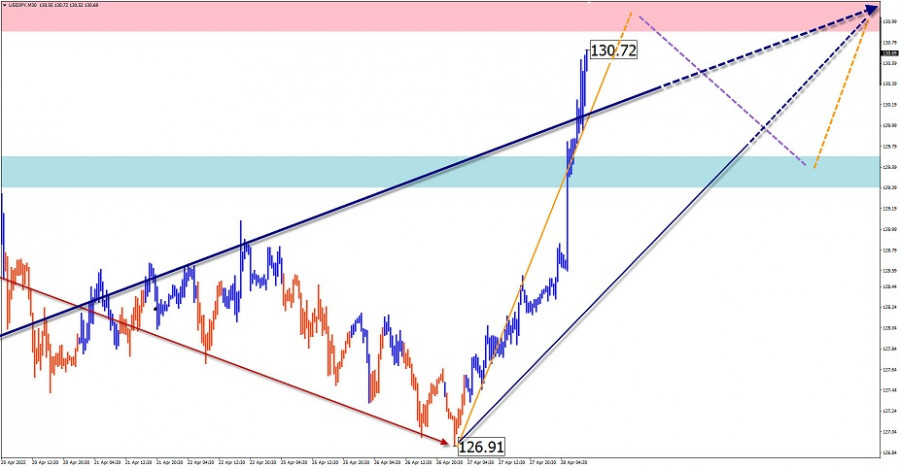
EUR/USD
Analysis:
The direction of movement of the main pair of the pan-European currency since the beginning of last year is set by a downward trend. At the beginning of this week, the quotes reached the boundaries of a wide potential reversal zone of the monthly scale of the chart. The price rise that began yesterday has a reversal potential and may be the beginning of an upward correction of the last trend area.
Forecast:
Today, the price movement is expected to move mainly to the lateral plane, between the nearest oncoming zones. In the first half of the day, pressure on support is possible. By the end of the day, the probability of a course change and a price rise to the resistance zone increases.
Potential reversal zones
Resistance:
- 1.0570/1.0600
Support:
- 1.0500/1.0470
Recommendations:
Today, trading activity in the euro market is more risky and can lead to deposit losses. After the appearance of reversal signals in the support zone, short-term purchases with a fractional lot are possible. It is optimal to refrain from trading transactions until the current price rise is fully completed.

USD/JPY
Analysis:
Quotes of the Japanese yen have been losing ground since the beginning of last year relative to the US dollar. The growth of the exchange rate led the price of the pair to the area of a powerful resistance zone of the weekly TF. The price is closely approaching its upper limit.
Forecast:
In the coming days, the upward movement vector is expected to continue, until the price rise is fully completed. In the resistance area, you can then wait for the formation of a reversal and the beginning of a decline, no further than the calculated support.
Potential reversal zones
Resistance:
- 130.90/131.20
Support:
- 129.70/129.40
Recommendations:
Purchases on the pair's market have limited potential. It is safer to close them at the first signals of a reversal. There are no conditions for sale on the major yen market today.

GBP/JPY
Analysis:
In the short term, the unfinished wave of the pound/yen cross chart is directed to the "north", counting from March 7. The middle part (B) has been completed in the structure. Since April 27, its final part (C) has started as an impulse.
Forecast:
During the current day, a general upward direction of the pair's movement is expected. In the next session, a short-term decline is possible, no further than the lower limit of support. The greatest activity is likely by the end of the day or tomorrow.
Potential reversal zones
Resistance:
- 164.50/164.80
Support:
- 163.30/163.00
Recommendations:
There are no conditions for sale on the pair's market today. At the end of the downward pullbacks, it is recommended to monitor the emerging signals of your vehicles for purchase. It is worth considering the high probability of counter kickbacks.
GOLD
Analysis:
The descending wave algorithm, which began on March 8, continues on the gold chart. The wave structure does not look complete. In the last decade, the quotes of the instrument formed the final part (C). At the time of analysis, the price reached the upper limit of the powerful support of a large TF.
Forecast:
In the coming days, quotes are expected to move in the price corridor designated by the counter settlement zones. In Europe, a general upward course of movement is more likely. An increase in volatility and a possible exchange rate change can be expected at the end of the day or tomorrow.
Potential reversal zones
Resistance:
- 1910.0/1915.0
Support:
- 1875.0/1870.0
Recommendations:
In the gold market today, trading carries increased risk and can lead to losses. It is optimal to refrain from transactions during the price rollback. After the appearance of reversal signals in the resistance zone, short-term sales will become possible.
Explanations: In the simplified wave analysis (UVA), waves consist of 3 parts (A-B-C). The last incomplete wave is analyzed. The solid background of the arrows shows the formed structure, and the dotted one shows the expected movements.
Attention: The wave algorithm does not take into account the duration of the movements of the instrument in time!